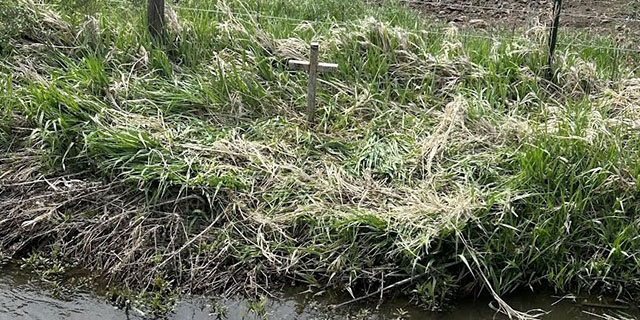Oregon 2004 fall season big game forecast
Published 5:00 pm Wednesday, September 22, 2004

- Bird hunters have reported seeing good numbers of bucks, like these near Enterprise, in Wallowa County this year. Photo by Michael Lane
(Reprinted in part from Oregon Hunter magazine.)
Oregon big game seasons are here and it’s time to begin doing some planning for your hunts, and assessing the overall outlook is a good place to start. For 2004, reduction in tag numbers and hunts is the order of the day for deer and elk in many parts of Oregon. The news is not all bad, though, and hunters will still find good opportunities to bag those animals depending on what units they intend to hunt. For other big game, stable or increasing populations seem to be the trend. Here is a roundup of the current big game situation based on interviews with Oregon Department of Fish and Wildlife biologists from various regions of the state.
Elk
Dave Nusom, ODFW district biologist on the north coast, reports a pretty good population of Roosevelt elk in his district. “Bull ratios are above management objectives for the Saddle Mountain, Wilson and Trask units,” he said. “There should be pretty good numbers of bulls and a fair number of branch-only.”
Down in Douglas County, the situation is a bit different. “We’ve got declining elk numbers in the Cascades and we’re cutting back the number of cow hunts in half,” said ODFW district wildlife biologist Tod Lum. One of the victims of the cutback includes the longstanding Upper North Umpqua Hunt, which has been ongoing for some 20 years. Lum attributes much of this decline to changes in forest management practices, including less logging, and to some extent, predation.
In the Coast Range portions of the district, it’s a different story. “In my district, there are more elk in the Coast Range than the Cascades,” continued Lum. For hunters in southwest Oregon who are up to the challenge, the rugged, heavily vegetated terrain of the Coast Range might be worth some serious consideration this season.
Over Grant County way, district wildlife biologist Darren Bruning said there are lots of elk throughout his district. “Bull ratios are stable or at management objectives and in a few places are increasing,” he explained. In addition, calf ratios are at their highest since 2002. While elk are pretty evenly distributed throughout the district, Bruning suggested that the Murderers Creek Unit, with its upward trend in bull and calf ratios, might have a little more to offer elk hunters this year.
For the Upper Deschutes, Metolius and Paulina units of central Oregon, it’s a mixed bag, with Rocky Mountain elk numbers stable to declining slightly. Elk are faring a bit better in the two Cascades units. ODFW biologist Steve George in Bend reported that bull survival has been good, and largely similar to previous years.
In northeast Oregon, Enterprise-based district wildlife biologist Vic Coggins said that the elk in some units are doing pretty well and not so well in others. Calf survival seems to be the primary factor here. The Imnaha, Chesnimnus and Sled Springs units are doing OK with 20 to 30 percent calf ratios. On the other hand, the Minam and Wenaha have low calf survival. In the Minam, calf survival is down to around 25 percent of management objectives.
“We do have some units with pretty good bull ratios, though,” Coggins said. “Hunters will have to look at their preference points and the odds for different units.” He cautions that there is usually a reason when tags for a particular unit are easier to get. The Minam Unit is a good example. “It’s rugged country,” Coggins said. “You really need horses.”
In southeast Oregon, Hines-based district wildlife biologist Ron Garner reported that elk are stable, although there has been lower calf survival of late due to predation and the effects of drought. Most elk in the High Desert country will be found in pockets of good habitat. The Malheur River, Silvies, Wagontire and Steens units are the region’s prime elk country.
ODFW approved a five-percent reduction in controlled rifle bull and either-sex tags, a 16-percent decrease in controlled antlerless rifle tags, along with several new hunts and hunt boundary modifications.
Black-tailed deer
“I think we’ve all had our marching orders to cut back on black-tailed deer tags,” said Lum matter-of-factly. Blacktails have been experiencing declines throughout their range in western Oregon, due, in part, to changing forest management practices, and more seriously, from disease, and deer hair loss syndrome in particular.
On the north coast, Nusom reported essentially the same thing.
Nevertherless, the situation is far from bleak. “The tag numbers have been cut back on does, but hunters will still be able to find their bucks,” Lum said.
Regulation changes in the works include continued reductions in antlerless hunts, elimination of the 800-Series hunts in 2005, shortening the western Oregon general rifle season by five days along with some bag limit and hunt schedule changes.
MULE DEER
Mule deer populations have experienced steady declines through the western U.S. over the past several decades. Although nowhere near their numbers from the 1970s, Oregon populations have been relatively steady. All is not completely rosy, however, said ODFW game program manager Tom Thornton. “There is some concern for buck ratios that are at or below management objectives.” A relatively hard winter has had some impacts as well.
“Our deer population in the back country and wilderness areas is pretty low,” Coggins said. “We think it’s a function of predators.” Coggins advised hunters in his part of the state to expect fewer yearling bucks in the Chesnimnus and Sled Springs units. One exception is the western end of the Sled Springs Unit, which has good mule deer numbers.
Down in southeast Oregon, the mule deer situation is largely the same. Last winter was the hardest in that area since 1992-93, which had an impact on mule deer herds, combined with predation. Some populations are having difficulty bouncing back. “With as few deer as we have,” Garner said, “it doesn’t take a lot of predators to keep the deer population down. We’ve also had a few years of drought, which hasn’t helped any.”
While the overall mule deer population is down in central Oregon also, fawn survival has been very good, ranging from 80 percent to 100 percent. “The buck ratios are up slightly,” George said. “I expect pretty good success for the buck season.”
Buck ratios in the Metolius Unit are around 18 bucks per 100 does (the MO is 25). The buck ratio in the Upper Deschutes Unit is 18 per 100 does, three points above MO, and the Paulina Unit is at about 90 percent of MO.
The Grant County area is an exception to the overall mule deer trend. “In our part of the state, we have seen an increase in mule deer since 1993,” says Bruning. Fawn survival is up significantly in all Bruning’s units. Buck ratios are at 11 per 100 in the Northside and Murderers Creek units – slightly down from the MO of 15.
Some additions and deletions to antler-less mule deer hunts, the addition of a second bow season on Hart Mountain National Antelope Refuge and an overall 13-percent reduction in statewide deer tags are among the regulation changes now under consideration.
BIGHORN SHEEP
Although there have been some disease problems associated with domestic sheep in northeast Oregon, bighorn populations are generally stable throughout their range.
Bighorn sheep hunting regulation changes in the works include a 10-percent increase in the number of tags for 2004. One new hunt and substantial boundary changes for two existing hunts are being considered for 2005.
ROCKY MOUNTAIN GOAT
“Rocky Mountain goats are doing well,” Coggins reported. “We only survey them in the summer so we don’t know for sure how they are doing in the winter, but our experience said they do just fine.” ODFW has been conducting re-introductions of goats into the Elkhorn and Wallowa mountains in recent years; the result is a solid, increasing population.
ODFW approved an additional tag for 2004, for a total of five. Two new hunts for 2005 are also on the drawing board.
BLACK BEAR AND COUGAR
“Cougar and black bear populations seem to be stable or increasing,” Thornton said, a fact that will come as no surprise to most hunters.
The highest densities of black bears are in western Oregon, where rugged terrain and dense vegetation make them difficult to hunt. “The bear population is holding or increasing on the north coast,” Nusom said, but because of the deep forest conditions “not a lot of bears are taken here.” The same holds true for cougar as well.
“If you want to hunt bear,” says Lum, whose district encompasses Douglas County, “the rule of thumb is that the further west to the coast and the further south you go, you’ll have higher bear densities.”
Southwest Oregon, along with the northwest part of the state, has very high cougar populations. Lum reports that some hunters are having good luck drawing in the big cats with elk and turkey calls.
“We encourage people to get cougar tags,” Coggins said, “so they can legally take one incidentally while they are deer or elk hunting.”
In his neck of the woods, Coggins suggested the Snake River, Chesnimnus, Minam and Wenaha units as good areas to go looking for cougars, and the Snake River, Wenaha and Sled Springs units as prime bear country.
A four-percent increase in spring bear tags for 2005 is in the plans, along with one new hunt. Expanding the Blue Mountains additional cougar tag to include all of eastern Oregon is also under review.





